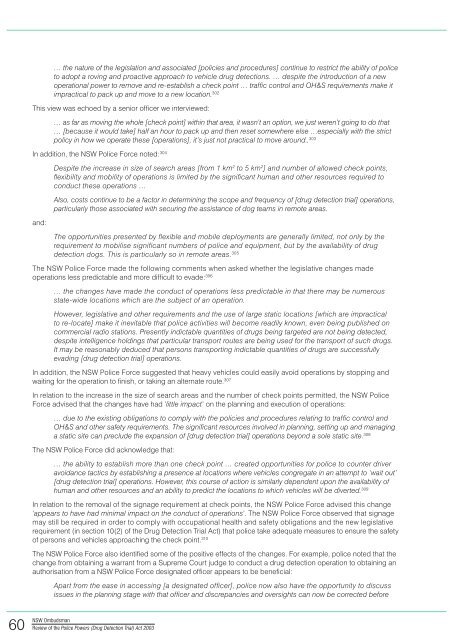Review of the Police Powers (Drug Detection Trial) Act 2003 - NSW ...
Review of the Police Powers (Drug Detection Trial) Act 2003 - NSW ...
Review of the Police Powers (Drug Detection Trial) Act 2003 - NSW ...
Create successful ePaper yourself
Turn your PDF publications into a flip-book with our unique Google optimized e-Paper software.
… <strong>the</strong> nature <strong>of</strong> <strong>the</strong> legislation and associated [policies and procedures] continue to restrict <strong>the</strong> ability <strong>of</strong> police<br />
to adopt a roving and proactive approach to vehicle drug detections. … despite <strong>the</strong> introduction <strong>of</strong> a new<br />
operational power to remove and re-establish a check point … traffic control and OH&S requirements make it<br />
impractical to pack up and move to a new location. 302<br />
This view was echoed by a senior <strong>of</strong>ficer we interviewed:<br />
… as far as moving <strong>the</strong> whole [check point] within that area, it wasn’t an option, we just weren’t going to do that<br />
… [because it would take] half an hour to pack up and <strong>the</strong>n reset somewhere else …especially with <strong>the</strong> strict<br />
policy in how we operate <strong>the</strong>se [operations], it’s just not practical to move around.. 303<br />
In addition, <strong>the</strong> <strong>NSW</strong> <strong>Police</strong> Force noted: 304<br />
and:<br />
Despite <strong>the</strong> increase in size <strong>of</strong> search areas [from 1 km 2 to 5 km 2 ] and number <strong>of</strong> allowed check points,<br />
flexibility and mobility <strong>of</strong> operations is limited by <strong>the</strong> significant human and o<strong>the</strong>r resources required to<br />
conduct <strong>the</strong>se operations …<br />
Also, costs continue to be a factor in determining <strong>the</strong> scope and frequency <strong>of</strong> [drug detection trial] operations,<br />
particularly those associated with securing <strong>the</strong> assistance <strong>of</strong> dog teams in remote areas.<br />
The opportunities presented by flexible and mobile deployments are generally limited, not only by <strong>the</strong><br />
requirement to mobilise significant numbers <strong>of</strong> police and equipment, but by <strong>the</strong> availability <strong>of</strong> drug<br />
detection dogs. This is particularly so in remote areas. 305<br />
The <strong>NSW</strong> <strong>Police</strong> Force made <strong>the</strong> following comments when asked whe<strong>the</strong>r <strong>the</strong> legislative changes made<br />
operations less predictable and more difficult to evade: 306<br />
… <strong>the</strong> changes have made <strong>the</strong> conduct <strong>of</strong> operations less predictable in that <strong>the</strong>re may be numerous<br />
state-wide locations which are <strong>the</strong> subject <strong>of</strong> an operation.<br />
However, legislative and o<strong>the</strong>r requirements and <strong>the</strong> use <strong>of</strong> large static locations [which are impractical<br />
to re-locate] make it inevitable that police activities will become readily known, even being published on<br />
commercial radio stations. Presently indictable quantities <strong>of</strong> drugs being targeted are not being detected,<br />
despite intelligence holdings that particular transport routes are being used for <strong>the</strong> transport <strong>of</strong> such drugs.<br />
It may be reasonably deduced that persons transporting indictable quantities <strong>of</strong> drugs are successfully<br />
evading [drug detection trial] operations.<br />
In addition, <strong>the</strong> <strong>NSW</strong> <strong>Police</strong> Force suggested that heavy vehicles could easily avoid operations by stopping and<br />
waiting for <strong>the</strong> operation to finish, or taking an alternate route. 307<br />
In relation to <strong>the</strong> increase in <strong>the</strong> size <strong>of</strong> search areas and <strong>the</strong> number <strong>of</strong> check points permitted, <strong>the</strong> <strong>NSW</strong> <strong>Police</strong><br />
Force advised that <strong>the</strong> changes have had ‘little impact’ on <strong>the</strong> planning and execution <strong>of</strong> operations:<br />
… due to <strong>the</strong> existing obligations to comply with <strong>the</strong> policies and procedures relating to traffic control and<br />
OH&S and o<strong>the</strong>r safety requirements. The significant resources involved in planning, setting up and managing<br />
a static site can preclude <strong>the</strong> expansion <strong>of</strong> [drug detection trial] operations beyond a sole static site. 308<br />
The <strong>NSW</strong> <strong>Police</strong> Force did acknowledge that:<br />
… <strong>the</strong> ability to establish more than one check point … created opportunities for police to counter driver<br />
avoidance tactics by establishing a presence at locations where vehicles congregate in an attempt to ‘wait out’<br />
[drug detection trial] operations. However, this course <strong>of</strong> action is similarly dependent upon <strong>the</strong> availability <strong>of</strong><br />
human and o<strong>the</strong>r resources and an ability to predict <strong>the</strong> locations to which vehicles will be diverted. 309<br />
In relation to <strong>the</strong> removal <strong>of</strong> <strong>the</strong> signage requirement at check points, <strong>the</strong> <strong>NSW</strong> <strong>Police</strong> Force advised this change<br />
‘appears to have had minimal impact on <strong>the</strong> conduct <strong>of</strong> operations’. The <strong>NSW</strong> <strong>Police</strong> Force observed that signage<br />
may still be required in order to comply with occupational health and safety obligations and <strong>the</strong> new legislative<br />
requirement (in section 10(2) <strong>of</strong> <strong>the</strong> <strong>Drug</strong> <strong>Detection</strong> <strong>Trial</strong> <strong>Act</strong>) that police take adequate measures to ensure <strong>the</strong> safety<br />
<strong>of</strong> persons and vehicles approaching <strong>the</strong> check point. 310<br />
The <strong>NSW</strong> <strong>Police</strong> Force also identified some <strong>of</strong> <strong>the</strong> positive effects <strong>of</strong> <strong>the</strong> changes. For example, police noted that <strong>the</strong><br />
change from obtaining a warrant from a Supreme Court judge to conduct a drug detection operation to obtaining an<br />
authorisation from a <strong>NSW</strong> <strong>Police</strong> Force designated <strong>of</strong>ficer appears to be beneficial:<br />
Apart from <strong>the</strong> ease in accessing [a designated <strong>of</strong>ficer], police now also have <strong>the</strong> opportunity to discuss<br />
issues in <strong>the</strong> planning stage with that <strong>of</strong>ficer and discrepancies and oversights can now be corrected before<br />
60<br />
<strong>NSW</strong> Ombudsman<br />
<strong>Review</strong> <strong>of</strong> <strong>the</strong> <strong>Police</strong> <strong>Powers</strong> (<strong>Drug</strong> <strong>Detection</strong> <strong>Trial</strong>) <strong>Act</strong> <strong>2003</strong>

















